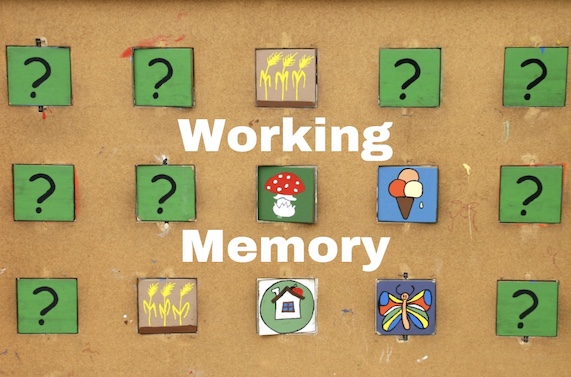
Written by Jennifer Cox LCPC
Last week we discussed Response Inhibition. Now let’s talk about Working Memory, another Executive Function.
Working memory is the retention of thoughts or information, keeping it in a place that is readily accessible so it’s available when needed.
Working memory also helps the brain organize new information for long-term storage, connecting it with other information.
When people have trouble with working memory, the brain may store information in a jumbled way, might not make that connection within the long-term memory, or one might struggle accessing when needed.
We use working memory every day, in many situations: to read, write, plan, organize, follow a conversation, do math, or follow multi-step directions. It facilitates planning, comprehension, reasoning, and problem-solving. It helps us stay focused and engaged with a task. Here are some examples:
- Listening and responding appropriately when having a conversation
- Carrying out instructions – Especially ones with multiple steps
- Reading comprehension
- Answering questions – Remembering what the question was and how to formulate an answer
- Following the steps in a recipe when no longer looking at the recipe
- Remembering conversations long enough to think about what you would like to contribute
- Daily organization
- Problem solving
What does a poor working memory look like? Here are some examples:
- Consistently losing items such as keys, cell phone, or wallet
- Getting lost easily, even when you were just given directions
- Trouble following conversations, not able to recall what others said
- Having unfinished projects because you get distracted, forget about the project you were working on, and begin a new one
- You forget to bring needed items with you to complete a task
- You have to reread a paragraph several times to retain the information
- You miss deadlines at work because you are disorganized and are unable to follow the steps needed
- You stop working on something because you have lost track of what you are supposed to do
- Difficulty applying what was learned in a previous experience to a new similar situation
What should I do? The first step to a better working memory is to understand how your memory works and to accept your limitations. Develop an understanding by monitoring yourself daily for at least a week. By doing so, you identify what type of support is needed such as the ones below, these work for all ages at home, school, and work:
- Develop routines – Create routines to help with daily tasks such as where to keep daily items, morning/evening routines, or chore routines, etc.
- Reduce the amount of information to be stored, for example use visuals such as a dry erase board or paper calendar, so your mind doesn’t have to hold on to information.
- Use checklists for tasks with multiple steps – Create a checklist for the day, identifying the tasks that are priority of the day, remember it is okay to move non-priority tasks to the next day when needed.
- Simplify information to make it easier to process – Break big chunks of information down into smaller, moving on to the next instruction one at a time, ignore the rest of the tasks until you are done with the first.
- Reduce multitasking – According to a study completed at the University of Sussex, multitasking can actually shrink certain areas of your brain and is linked to shortened attention spans.
- Repeating information within your head, to keep present.
- Practice working memory skills – Write down 10 unrelated words, then start by trying to remember the first 2 words without looking at the paper and add another word as you succeed, play memory games, or in the evening process what occurred in the day via paper or mind.
- Try different ways to remember information – Create a song or make up a rhyme for lists. Try visualization to remember multiple items such as imagine yourself completing the list.
- Use mindfulness to decrease distractions and keep present in the moment – Harvard found that mindfulness increased recall and allowed participants to tune out distractions. By being mindful you are engaged in the moment, which in the ends helps with retention.
- Exercise on a regular basis – Some studies have shown that working memory increases with daily exercise. Scientists believe physical activity improves brain health. It can also indirectly affect memory by improving mood, helping you sleep better, and reducing stress – Areas that can affect cognitive abilities.
References – For more information on topics above, see below:
https://www.apa.org/monitor/sep05/
https://www.sussex.ac.uk/broadcast/read/26540
https://www.gse.harvard.edu/ideas/usable-knowledge/19/01/making-time-mindfulness
https://www.ncbi. nlm.nih.gov/pmc/articles
Understanding each of the executive functions and how they can impact your day to day, can help one understand why ADHD is a serious disorder – This is a disorder that involves self-control, self-care, self-regulation, and self-motivation to get through your day.
For more information or help with executive functioning, contact 815-363-0864 or info@echcounseling.com

